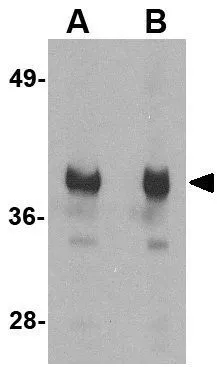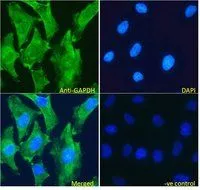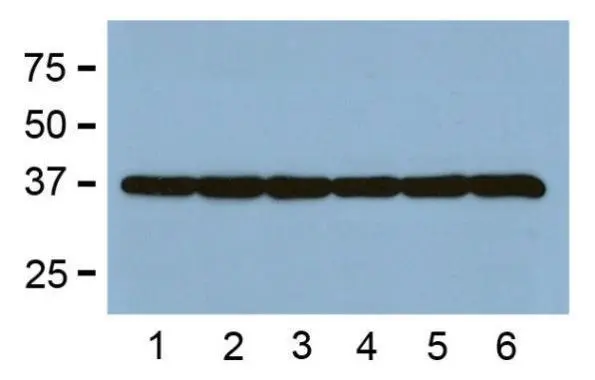![ICC/IF analysis of NIH-3T3 cells using GTX03407 GAPDH antibody [GT1355]. Red : Primary antibody Blue : DAPI for nuclear staining Dilution : 1:100 ICC/IF analysis of NIH-3T3 cells using GTX03407 GAPDH antibody [GT1355]. Red : Primary antibody Blue : DAPI for nuclear staining Dilution : 1:100](https://www.genetex.com/upload/website/prouct_img/normal/GTX03407/GTX03407_ICCIF_1_w_23053123_726.webp)
ICC/IF analysis of NIH-3T3 cells using GTX03407 GAPDH antibody [GT1355]. Red : Primary antibody Blue : DAPI for nuclear staining Dilution : 1:100
GAPDH antibody [GT1355]
GTX03407
ApplicationsImmunoFluorescence, Western Blot, ImmunoCytoChemistry, ImmunoHistoChemistry, ImmunoHistoChemistry Paraffin
Product group Antibodies
TargetGAPDH
Overview
- SupplierGeneTex
- Product NameGAPDH antibody [GT1355]
- Delivery Days Customer9
- ApplicationsImmunoFluorescence, Western Blot, ImmunoCytoChemistry, ImmunoHistoChemistry, ImmunoHistoChemistry Paraffin
- CertificationResearch Use Only
- ClonalityMonoclonal
- Clone IDGT1355
- ConjugateUnconjugated
- Gene ID2597
- Target nameGAPDH
- Target descriptionglyceraldehyde-3-phosphate dehydrogenase
- Target synonymsG3PD, GAPD, HEL-S-162eP, glyceraldehyde-3-phosphate dehydrogenase, OCAS, p38 component, Oct1 coactivator in S phase, 38 Kd component, aging-associated gene 9 protein, epididymis secretory sperm binding protein Li 162eP, peptidyl-cysteine S-nitrosylase GAPDH
- HostRabbit
- IsotypeIgG
- Protein IDP04406
- Protein NameGlyceraldehyde-3-phosphate dehydrogenase
- Scientific DescriptionThis gene encodes a member of the glyceraldehyde-3-phosphate dehydrogenase protein family. The encoded protein has been identified as a moonlighting protein based on its ability to perform mechanistically distinct functions. The product of this gene catalyzes an important energy-yielding step in carbohydrate metabolism, the reversible oxidative phosphorylation of glyceraldehyde-3-phosphate in the presence of inorganic phosphate and nicotinamide adenine dinucleotide (NAD). The encoded protein has additionally been identified to have uracil DNA glycosylase activity in the nucleus. Also, this protein contains a peptide that has antimicrobial activity against E. coli, P. aeruginosa, and C. albicans. Studies of a similar protein in mouse have assigned a variety of additional functions including nitrosylation of nuclear proteins, the regulation of mRNA stability, and acting as a transferrin receptor on the cell surface of macrophage. Many pseudogenes similar to this locus are present in the human genome. Alternative splicing results in multiple transcript variants. [provided by RefSeq, Nov 2014]
- Storage Instruction-20°C or -80°C,2°C to 8°C
- UNSPSC12352203

![ICC/IF analysis of C6 cells using GTX03407 GAPDH antibody [GT1355]. Red : Primary antibody Blue : DAPI for nuclear staining Dilution : 1:100 ICC/IF analysis of C6 cells using GTX03407 GAPDH antibody [GT1355]. Red : Primary antibody Blue : DAPI for nuclear staining Dilution : 1:100](https://www.genetex.com/upload/website/prouct_img/normal/GTX03407/GTX03407_ICCIF_2_w_23053123_266.webp)
![IHC-P analysis of human placenta tissue using GTX03407 GAPDH antibody [GT1355]. Antigen retrieval : Microwave antigen retrieval with 10 mM PBS buffer pH 7.2 Dilution : 1:100 IHC-P analysis of human placenta tissue using GTX03407 GAPDH antibody [GT1355]. Antigen retrieval : Microwave antigen retrieval with 10 mM PBS buffer pH 7.2 Dilution : 1:100](https://www.genetex.com/upload/website/prouct_img/normal/GTX03407/GTX03407_IHC-P_1_w_23053123_794.webp)
![WB analysis of various sample lysates using GTX03407 GAPDH antibody [GT1355]. Dilution : 1:1000 Loading : 25microg per lane WB analysis of various sample lysates using GTX03407 GAPDH antibody [GT1355]. Dilution : 1:1000 Loading : 25microg per lane](https://www.genetex.com/upload/website/prouct_img/normal/GTX03407/GTX03407_WB_1_w_23053123_546.webp)
![WB analysis of HeLa cell lysates using serially diluted GTX03407 GAPDH antibody [GT1355]. Loading : 25microg per lane WB analysis of HeLa cell lysates using serially diluted GTX03407 GAPDH antibody [GT1355]. Loading : 25microg per lane](https://www.genetex.com/upload/website/prouct_img/normal/GTX03407/GTX03407_WB_2_w_23053123_481.webp)
![WB analysis of various sample lysates using GTX03407 GAPDH antibody [GT1355]. Dilution : 1:10000 Loading : 25microg per lane WB analysis of various sample lysates using GTX03407 GAPDH antibody [GT1355]. Dilution : 1:10000 Loading : 25microg per lane](https://www.genetex.com/upload/website/prouct_img/normal/GTX03407/GTX03407_WB_3_w_23053123_910.webp)
![WB analysis of multiple cell and tissue lysates (Lanes 1-23 : 293, A431, A549, Daudi, HeLa, HepG2, Jurkat, K562, MOLT, 3T3, Raji, Ramos, U937, human brain, mouse brain, rat brain, rabbit brain, human heart, rat heart, human liver, mouse liver, rat liver, rabbit liver) using GTX17307 GAPDH antibody [12D3H9]. Working concentration : 1 microg/ml](https://www.genetex.com/upload/website/prouct_img/normal/GTX17307/GTX17307_2440_WB_20180221_w_23060620_283.webp)
![ICC/IF analysis of methanol-fixed HepG2 (left) and HeLa (right) cells using GTX83245 GAPDH antibody [1A10]. Green : GAPDH Blue: DRAQ5 fluorescent DNA dye](https://www.genetex.com/upload/website/prouct_img/normal/GTX83245/GTX83245_20170912_ICCIF_w_23061322_576.webp)




![ICC/IF analysis of HeLa cells using GTX33615 GAPDH antibody [RM114]. Red : Primary antibody Green : Actin Blue : DAPI Dilution : 1:200](https://www.genetex.com/upload/website/prouct_img/normal/GTX33615/GTX33615_20200909_ICCIF_162_w_23060800_928.webp)